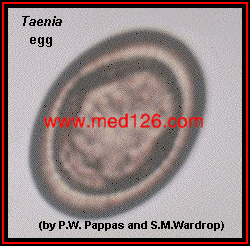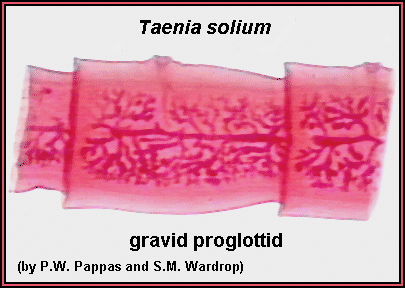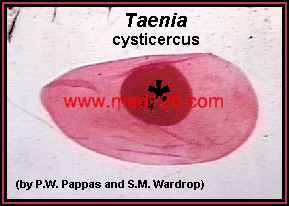There are several species of Taenia that humans are likely to encounter. These include two species for which humans serve as the definitive host: Taenia saginata (now often called Taeniarhynchus saginatus), the beef tapeworm; and T. solium, the pork tapeworm. Several species of Taenia also infect dogs and cats (e.g.,T. pisiformis), and humans are likely to encounter these when they note the presence of these tapeworms' proglottids in their pets' feces.
All species of Taenia have similar life cycles. The adult tapeworm lives in the definitive host's small intestine. Proglottids, which contain eggs, break off the posterior end of the tapeworm, and these proglottids are either passed intact in the host's feces or they dissolve in the host's intestine and eggs are passed in the feces. The eggs of Taenia have a characteristic appearance (see below), but they can not be differentiated to species. The intermediate host is infected when it ingests the eggs, and a cysticercus develops in the intermediate host. The definitive host is infected when it eats an intermediate host infected with cysticerci . As adults in the definitive host's small intestine, tapeworms rarely cause problems; in exceptional cases the tapeworms might physically block the intestinal tract, due to their large size, or proglottids might become lodged in the appendix and result in appendicitis. The proglottids of Taenia are large and muscular. Occasionally single proglottids or long chains of proglottids might crawl out of the anus of an infected human. Understandably, most humans would find this quite disturbing, and it surely would not be an appropriate topic for "polite conversation."
Although adult tapeworms in humans rarely cause problems, humans can also be infected with cysticerci. Such an infection is referred to as cysticercosis, and this can result in significant pathology.
Infections with Taenia are diagnosed by recovering eggs or proglottids in the feces of an infected host. The eggs of T. saginata and T. solium are virtually identical, but these two species can be differentiated based on the morphology of their proglottids and scolex (holdfast). However, since the same drugs are used for treating both species, such differentiation is generally unnecessary. The proglottids of canine and feline species of Taenia are rectangular and larger than those of Dipylidium caninum, thus making differentiation of these species relatively simple.

A stained whole mount of the scolex (holdfast) of Taenia solium, the pork tapeworm; the scolex measures approximately 1 mm across. The four suckers are numbered. Note the presence of an armed (hooked) rostellum (*); the scolex of Taenia saginata, the beef tapeworm, does not have an armed rostellum.

A stained whole mount of the scolex of Taenia solium. The scolex was crushed when this preparation was made to emphasize the shape of the rostellar hooks.

Taenia egg. Note the thick, "striated" shell and several of the larval hooks; approximate size = 40 µm. Eggs of all species of Taenia look like this example. (Original image from "Atlas of Medical Parasitology.")

Another example of a Taenia egg showing the thick (striated) "shell." (Original image from Oklahoma State University, College of Veterinary Medicine.)

Anterior region of Taenia solium showing the scolex and neck region. The proglottids on the right are immature; note that the reproductive organs are just beginning to differentiate.

Mature proglottids of Taenia sp.
each proglottid measures about 4 mm in length.

A gravid proglottid of Taenia solium.
In this species the uterus of the gravid proglottid has between 7 and 13 lateral branches on each side. In T. saginata the uterus of the gravid proglottid has between 15 and 20 lateral branches on each side.

A cysticercus (stained whole mount) of Taenia sp.
The cysticercus consists of scolex or holdfast (*) within a large "bladder;" hence, cysticerci are often referred to a "bladder worms." This cysticercus measures approximately 5 mm across.

A cysticercus of Taenia in muscle.
Note the fibrous capsule (*) around the cysticercus.